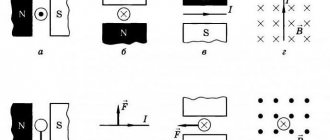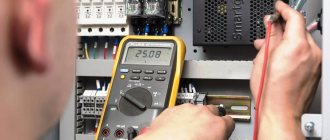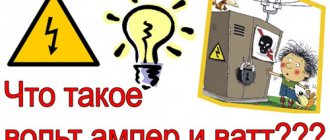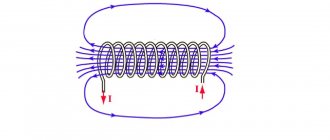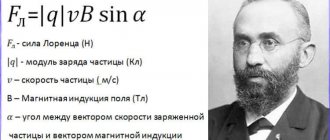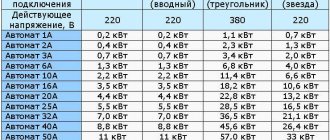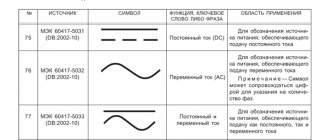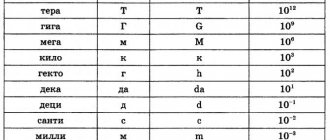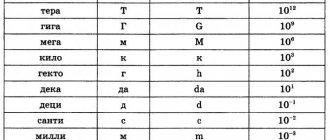Charged particles, when moving longitudinally through a conductor, transfer an electric charge. The movement of charges is called electric current. In metal conductors this is the movement of electrons. The amount of charge transferred in the same period of time depends on the number of electrons and the speed of their movement.
Current strength when moving through the cross section of a metal conductor
What characteristics determine the current strength of 1 ampere?
If you place a pair of meter-long conductors in parallel in a vacuum at a distance of 1 m and pass an electric current through them, they will interact with each other. When electricity flows in one direction, conductors will attract, and in different directions they will repel. This phenomenon was considered as determining the unit of current. The value that caused the interaction of these conductors with each other with a force of 2 * 10-7 N was considered to be a current strength equal to 1 Ampere. The unit is named after A. M. Ampere, a Frenchman, and adopted for designation in the SI system.
Interaction of conductors in a vacuum when connecting electricity
Information. The rate at which charges flow through a metal conductor is what is measured in amperes. The amount of electricity of 1 coulomb (C) passing through the Ssection of the current conductor in 1 second (s) is equal to the current strength of 1 Ampere (A).
How many Watts are in 1 Ampere and amperes in a cotton wool?
To convert Watts to Amps at alternating or direct voltage you will need the formula:
I = P/U, where
I is the current strength in amperes; P – power in watts; U – voltage in volts, if the network is three-phase , then I = P/(√3xU), since it is necessary to take into account the voltage in each of the phases.
The root of three is approximately equal to 1.73.
That is,
in one watt there is 4.5 mAm (1A = 1000 mAm) at a voltage of 220 volts and 0.083 Am at 12 volts .
When it is necessary to convert current into power (find out how many watts are in 1 ampere), then use the formula:
P = I * U or P = √3 * I * U, if calculations are carried out in a 3-phase 380 V network.
This means that if we are dealing with a 12-volt automotive network, then 1 ampere is 12 Watts, and in a 220 V household electrical network, this current strength will be in an electrical appliance with a power of 220 W (0.22 kW). In industrial equipment powered by 380 Volts, as much as 657 Watts.
Ampere – Watt conversion table:
| 6 | 12 | 24 | 220 | 380 | Volt | |
| 5 Watt | 0,83 | 0,42 | 0,21 | 0,02 | 0,008 | Ampere |
| 6 Watt | 1,00 | 0,5 | 0,25 | 0,03 | 0,009 | Ampere |
| 7 Watt | 1,17 | 0,58 | 0,29 | 0,03 | 0,01 | Ampere |
| 8 Watt | 1,33 | 0,67 | 0,33 | 0,04 | 0,01 | Ampere |
| 9 Watt | 1,5 | 0,75 | 0,38 | 0,04 | 0,01 | Ampere |
| 10 Watt | 1,67 | 0,83 | 0,42 | 0,05 | 0,015 | Ampere |
| 20 Watt | 3,33 | 1,67 | 0,83 | 0,09 | 0,03 | Ampere |
| 30 Watt | 5,00 | 2,5 | 1,25 | 0,14 | 0,045 | Ampere |
| 40 Watt | 6,67 | 3,33 | 1,67 | 0,13 | 0,06 | Ampere |
| 50 Watt | 8,33 | 4,17 | 2,03 | 0,23 | 0,076 | Ampere |
| 60 Watt | 10,00 | 5,00 | 2,50 | 0,27 | 0,09 | Ampere |
| 70 Watt | 11,67 | 5,83 | 2,92 | 0,32 | 0,1 | Ampere |
| 80 Watt | 13,33 | 6,67 | 3,33 | 0,36 | 0,12 | Ampere |
| 90 Watt | 15,00 | 7,50 | 3,75 | 0,41 | 0,14 | Ampere |
| 100 Watt | 16,67 | 8,33 | 4,17 | 0,45 | 0,15 | Ampere |
| 200 Watt | 33,33 | 16,67 | 8,33 | 0,91 | 0,3 | Ampere |
| 300 Watt | 50,00 | 25,00 | 12,50 | 1,36 | 0,46 | Ampere |
| 400 Watt | 66,67 | 33,33 | 16,7 | 1,82 | 0,6 | Ampere |
| 500 Watt | 83,33 | 41,67 | 20,83 | 2,27 | 0,76 | Ampere |
| 600 Watt | 100,00 | 50,00 | 25,00 | 2,73 | 0,91 | Ampere |
| 700 Watt | 116,67 | 58,33 | 29,17 | 3,18 | 1,06 | Ampere |
| 800 Watt | 133,33 | 66,67 | 33,33 | 3,64 | 1,22 | Ampere |
| 900 Watt | 150,00 | 75,00 | 37,50 | 4,09 | 1,37 | Ampere |
| 1000 Watt | 166,67 | 83,33 | 41,67 | 4,55 | 1,52 | Ampere |
Ampere's Law - Definition
Conductors and dielectrics
Andre Ampère in 1920 defined the force with which a magnetic field affects a conductor placed in it. He established a direct relationship between the force arising around the conductor, the strength of the current, the magnitude of magnetic induction and the sine of the angle between the magnetic induction vector and the direction of the current. The expression looks like:
FA = B *I*L*sinα,
Where:
- FA – Ampere force, N;
- B – magnetic induction module;
- I – current strength, A;
- L – length of the conductor section, m.
The definition is valid for a conductor along which there is a constantly directed movement of electrons.
Ohm's law
One of the laws of electrical engineering, which was derived through experimental research, is empirical. With its help, a connection is established between the resistance of the conductor, the voltage at its ends and the strength of the current passing through the conductor. Ohm Georg, a German physicist, in 1826 conducted a series of experiments and derived a relationship between these quantities, which can be revealed as follows: the current strength is directly dependent on the potential difference at the ends of the conductor and inversely on its resistance. Ohm's Law Formula:
Net power
I = U/R,
Where:
- I – current strength, A;
- U – voltage (potential difference), V;
- R – conductor resistance, Ohm.
An ampere is a unit of electricity in a section of a circuit, obtained by dividing a voltage of 1 volt by a resistance of 1 ohm.
Attention! From this expression, for example, it follows that if, with a constant resistance, the voltage is doubled, then the current will also double. If, at a constant voltage value, the resistance is doubled, then it will decrease by half.
Mnemonic rule for remembering the formula of Ohm's law
The formula is applied to a section of the circuit through which the movement of electrons occurs in one direction. In the case of alternating electricity with one phase, the formula changes form:
I = U/Z, where:
- I – current strength, A;
- U – potential difference, V;
- Z – total (complex) resistance of the circuit, Ohm.
If the circuit includes, along with active components, also reactive components, the direction of movement of electrons has harmonic oscillations, then this law describes the dependence of complex quantities.
Multiples and submultiples
Ampere is a rather large unit of measurement. Its submultiple units are designated by prefixes, which can be found in the international notation for SI units. In practice, only a few multiples of units are used to denote amperes. In order to decompose an ampere into shares or find out how many small quantities are included in it, there is a special program - an electronic calculator-converter.
Stray currents
Very small currents are calculated in thousandths of an ampere - milliamperes (mA), this is 1 * 10-3A. An even smaller value of this value is indicated in microamperes (μA), this is 1 * 10-6 A. Electronic circuits of modern gadgets work with such values.
Heating devices, lighting devices and large household appliances pass currents of 0.1 A and higher through their circuits.
Interesting. The human nervous system begins to respond to the passage of a current of 0.5 mA. Its value exceeding 50 mA is already dangerous to health. The action of an alternating current of 100 mA for 2-3 seconds is fatal.
Sub-multiple and multiple units of electricity
When determining the standard and calibrating instruments, it was necessary to measure the magnitude of the interaction between a pair of coils with windings made of a large number of turns of wire of a very small cross-section.
Relationship with other SI units
What amperes are from the point of view of the connection between electrical units can be seen in the following examples:
- at a current of 1 ampere (A), the cross-section of the conductor passes through itself a charge of 1 coulomb (C) in one second;
- when a charge of 1 ampere is applied to the plates of a capacitor with a capacity of 1 F, the voltage on the plates will increase, increasing by 1 V every second;
- the capacity of galvanic sources and batteries is measured in ampere-hours (A*h, or A*h), 1 A*h = 3660 C, this amount of electricity flows through the conductor in 1 hour;
- the maximum output power (watt) of rectifiers or power supplies is the second most important characteristic of such sources and is marked V*A;
- the amount of electricity in a lightning discharge is approximately 500 kiloamperes (1 kA = 10³ A);
- a 0.1 kilowatt (kW) incandescent light bulb consumes 0.5 A.
The designation of the number of amperes is applied to the housings of circuit breakers and fuses.
Power units
Converting watts to amperes and vice versa is a relative concept, because these are different units of measurement. Amps are a physical quantity of electric current, that is, the speed at which electricity flows through a cable. Watt is the amount of electrical power, or the rate of electricity consumption. But such a translation is necessary in order to calculate whether the value of the current corresponds to the value of its power.
Relationship with other SI units
What amperes are from the point of view of the connection between electrical units can be seen in the following examples:
- at a current of 1 ampere (A), the cross-section of the conductor passes through itself a charge of 1 coulomb (C) in one second;
- when a charge of 1 ampere is applied to the plates of a capacitor with a capacity of 1 F, the voltage on the plates will increase, increasing by 1 V every second;
- the capacity of galvanic sources and batteries is measured in ampere-hours (A*h, or A*h), 1 A*h = 3660 C, this amount of electricity flows through the conductor in 1 hour;
- the maximum output power (watt) of rectifiers or power supplies is the second most important characteristic of such sources and is marked V*A;
- the amount of electricity in a lightning discharge is approximately 500 kiloamperes (1 kA = 10³ A);
- a 0.1 kilowatt (kW) incandescent light bulb consumes 0.5 A.
The designation of the number of amperes is applied to the housings of circuit breakers and fuses.
Converting amperes to watts and kilowatts
Knowing how to calculate the correspondence between amperes and watts is necessary in order to determine which device can withstand the power of connected consumers. Such devices include protective equipment or switching equipment.
Before choosing which circuit breaker or residual current device (RCD) to install, you need to calculate the power consumption of all connected devices (iron, lamps, washing machine, computer, etc.). Or, on the contrary, knowing the cost of a circuit breaker or protective shutdown device, determine which equipment will withstand the load and which will not.
To convert amperes to kilowatts and vice versa, there is a formula: I=P/U, where I are amperes, P are watts, U are volts. Volts are the mains voltage. In residential premises, a single-phase network is used - 220 V. In production, to connect industrial equipment, a three-phase electrical network is used, the value of which is 380 V. Based on this formula, knowing the amperes, you can calculate the correspondence to watts and vice versa - convert watts to amperes.
Situation: There is a circuit breaker. Technical parameters: rated current 25 A, 1-pole. You need to calculate what wattage of devices the machine can withstand.
The easiest way is to enter technical data into a calculator and calculate the power. You can also use the formula I=P/U, it will turn out: 25 A=x W/220 V.
x W=5500 W.
To convert watts to kilowatts, you need to know the following measures of power in watts:
- 1000 W = 1 kW,
- 1000 000 W = 1000 kW = MW,
- 1000,000,000 W = 1,000 MW = 1,000,000 kW, etc.
This means 5500 W = 5.5 kW. Answer: a machine with a rated current of 25 A can withstand the load of all devices with a total power of 5.5 kW, no more.
Apply a formula with voltage and current data in order to select the type of cable based on power and current. The table shows the current correspondence to the wire cross-section:
Copper cores of wires and cablesCode cross-section, mm²Copper cores of wires, cables
| Voltage 220 V | Voltage 380 V | |||
| Current, A | power, kWt | Current, A | power, kWt | |
| 1,5 | 19 | 4,1 | 16 | 10,5 |
| 2,5 | 27 | 5,9 | 25 | 16,5 |
| 4 | 38 | 8,3 | 30 | 19,8 |
| 6 | 46 | 10,1 | 40 | 26,4 |
| 10 | 70 | 15,4 | 50 | 33 |
| 16 | 85 | 18,7 | 75 | 49,5 |
| 25 | 115 | 25,3 | 90 | 59,4 |
| 35 | 135 | 29,7 | 115 | 75,9 |
| 50 | 175 | 38,5 | 145 | 95,7 |
| 70 | 215 | 47,3 | 180 | 118,8 |
| 95 | 260 | 57,2 | 220 | 145,2 |
| 120 | 300 | 66 | 260 | 171,6 |
How to convert watt to ampere
You need to convert watts to amperes in a situation where you need to install a protective device and you need to choose what rated current it should have. It is clear from the operating instructions how many watts a household appliance connected to a single-phase network consumes.
The task is to calculate how many amperes in watts or what kind of socket to connect to if the microwave oven consumes 1.5 kW. For ease of calculation, it is better to convert kilowatts into watts: 1.5 kW = 1500 W. We substitute the values into the formula and get: 1500 W / 220 V = 6.81 A. We round the values up and get 1500 W in terms of amperes - microwave current consumption is at least 7 A.
If you connect several devices simultaneously to one protection device, then in order to calculate how many amperes there are in watts, you need to add all the consumption values together. For example, the room uses lighting with 10 pcs LED lamps. 6 W, iron 2 kW and TV 30 W. First, all indicators need to be converted into watts, it turns out:
- lamps 6*10= 60 W,
- iron 2 kW=2000 W,
- TV 30 W.
60+2000+30=2090 W.
Now you can convert amperes to watts, to do this we substitute the values in the formula 2090/220 V = 9.5 A ~ 10 A. Answer: current consumption is about 10 A.
You need to know how to convert amps to watts without a calculator. The table shows the correspondence between the rate of electricity consumption and the current strength for single-phase and three-phase networks.
| Ampere (A) | Power, kWt) | |
| 220 V | 380 V | |
| 2 | 0,4 | 1,3 |
| 6 | 1,3 | 3,9 |
| 10 | 2,2 | 6,6 |
| 16 | 3,5 | 10,5 |
| 20 | 4,4 | 13,2 |
| 25 | 5,5 | 16,4 |
| 32 | 7,0 | 21,1 |
| 40 | 8,8 | 26,3 |
| 50 | 11,0 | 32,9 |
| 63 | 13,9 | 41,4 |
Current strength in everyday life
In order to protect household networks from short circuits and overloads, automatic circuit breakers are installed in the alternating electricity circuit. These are switches designed for limit values at which the circuit is automatically disconnected.
So, a machine designed for 2 amperes will withstand a short-term load of up to 2 amperes; with a short-term load greater than 2 A, it will turn off. There is a concept called “time-current characteristic (TCC)”. This is a parameter that shows the dependence of the device’s response time on the ratio of the current passing through the switch to its rated response current.
VTX has letter indices that are applied to the body of the circuit breaker. They indicate the multiplicity of the installation of the electromagnetic disconnector to the rated current of the machine. This is the smallest value at which instantaneous shutdown will occur.
Letter indices denoting VTX are:
- V (3 – 5* In);
- C (5 – 10* In);
- D (10 – 20* In).
When installing electrical wiring, the maximum power of consumers and the cross-section of the wires used are calculated. When making calculations, make sure that the maximum current does not exceed the permissible value for the selected cross-section.
Current strength and wiring parameters
To determine the required cross-section of electrical wiring conductors and the rating of circuit breakers, convert the total number of watts into amperes and obtain the value of the maximum continuous current.
The correlation between the cross-section of the cores and the maximum permissible current for wiring is carried out using tables provided by cable manufacturers. Depending on the manufacturer, the main indicators may differ slightly, but they must always comply with the current GOST 31996-2012.
An example of a table of correspondence between the cross-section of current-carrying conductors and the maximum permissible continuous current depending on the method of wiring
Sometimes they choose wiring not with the minimum allowable cross-section, but with a slightly larger one. This is justified, since the bandwidth reserve allows you to connect new electrical appliances without costly dismantling old ones and laying new cables.
The parameters of the circuit breakers installed in the electrical panel are selected so that it is guaranteed to trip if the current exceeds the value determined as the maximum permissible for the installed wiring.
The rated current of the machine (In) is calculated from the permissible current for the cable (Ip) using the following formula:
In <= Ip / 1.45
Usually, a machine with the maximum nominal value among the permitted ones is selected in order to minimize the likelihood of a shutdown when the circuit is heavily, but still permissibly, loaded.
Future prospects for the current unit
Once it is determined what amperes are, the future prospects for this unit can be considered. In 2011, at an international conference, the conditions for the upcoming revision of unit designations in the SI system were agreed upon.
The proposed new standards should improve the accuracy of various measurements in any time, metric and geographical vectors without loss of accuracy. The ampere will not suffer any special changes, except that its value will be designated depending on this number.
Today, an ampere is the result of an imaginary process in which the occurrence of a force between two conductors of dimensionless length is represented. In practice, this is impossible to reproduce, because there are no such long and thin wires. At the conference they decided to apply a new idea. It will be based on physical constants or atomic properties. This physical constant will be the charge of the electron.
Attention! Modern definition: 1 ampere is the movement of electrons corresponding to a flow of 1/1.6 * 10-19 elementary charges per second.
A practical tool is a single-electron pump, which allows you to move a fixed number of electrons during one cycle.
In the future, ampere is a measure of current strength, the definition of which is no longer described by a fictitious virtual installation, but has acquired a solid, fundamental basis.
Converting units of measurement - online unit converter
Conversion of basic quantities used in physics, thermodynamics and engineering calculations. The quantity converter works with the main sections: weight, mass, time, length, etc. It also converts specific quantities used in heat power engineering: specific heat capacity, thermal conductivity, etc.
Unit converter
Allows you to convert between SI (metric) and alternative measurement systems.
Weight, mass
Weight, mass
Weight
- the force with which the body and the support of this body (or the suspension to which the body is attached) interact.
Weight
- a measure of the inert properties of a body.
If an arbitrary force in an inertial reference frame accelerates different bodies equally, then these bodies are assigned the same inertial mass. Fuel consumption
Fuel consumption
Fuel consumption
is the consumption of a unit of fuel per unit distance or per unit time.
It is one of the important characteristics of the engine.
Time
Time
Time
in classical physics is a continuous quantity, an a priori characteristic of the world. A certain sequence of periodic events (that is, occurring at regular intervals of time) is taken as the basis for measurement.
In relativistic physics, time is part of a single space-time, and, therefore, can change during its transformations.
Speed
Speed
Velocity
is a vector quantity that characterizes the speed of movement and direction of movement of a material point in space relative to the chosen reference system.
In science, speed is also used in a broad sense, that is, as the rate of change of any quantity.
Pressure
Pressure
Pressure
is a quantity that characterizes the state of a continuous medium and is numerically equal to the force acting per unit surface area perpendicular to this surface.
In most devices, the measured pressure is converted into the deformation of elastic elements, which is why they are called deformation devices.
Flow rate (wt.)
Flow rate (mass)
Flow velocity (mass)
is the mass of a substance passing through the cross section of the flow per unit time.
Length, distance
Length, distance
Length
is the size of an object in the longitudinal direction, that is, the distance between its two most distant points. It is one of the fundamental units of measurement from which other units are formed.
Distance
— the degree of distance of objects from each other.
Flow rate (rev)
Flow rate (volume)
Flow velocity (volumetric)
is a value characterizing the volumetric amount of a substance passing through the cross section of the flow per unit time.
Shares and percentages
Shares and percentages
A share
is a part of something; as well as the old Russian unit of measurement of mass.
Percent (%)
- one hundredth.
Used to indicate the proportion of something in relation to the whole. Temperature
Temperature
Temperature
is a quantity that approximately characterizes the average kinetic energy of particles of a system in a state of thermodynamic equilibrium per one degree of freedom.
In the SI system, temperature is measured in kelvins. But in practice, degrees Celsius are often used due to their connection to important characteristics of water.
Moment of force (rotational)
Moment of force (rotational)
Moment of force
is a quantity characterizing the rotational action of a force on a solid body.
Angular measure
Angular measure
An angle
is an unlimited geometric figure formed by two rays (sides of the angle) emerging from one point (the vertex of the angle).
Angle is also called angular measure.
Power
Power
Power
is a quantity equal to the ratio of the work performed over a certain period of time to this period of time.
Since work is a measure of change in energy, power can also be defined as the rate of change of energy of a system.
Acceleration
Acceleration
Acceleration
is the derivative of speed with respect to time - a vector quantity that shows how much the speed vector of a point changes as it moves per unit time.
Volume, capacity
Volume, capacity
Volume
is a measure that characterizes the capacity of the area of space that it occupies.
Capacity
often denote vessels, while volume often denotes what is contained (gas, liquid, granular solids) in a vessel.
There are no fundamental differences. Energy, work
Energy, work
Energy
is a quantity that is a single measure of various forms of motion of matter and a measure of the transition of the motion of matter from one form to another.
Job
— the amount of energy transmitted or received by the system.
Thermal conductivity
Thermal conductivity
Specific heat
Specific heat
Square
Square
Area
is a quantity that in some sense corresponds to the size of a surface.
In the simplest case, when a figure can be divided into a finite set of unit squares, the area is equal to the number of squares.
SI prefixes
SI prefixes
| Multiplicity | Console | Designation |
| 10-9 | nano | n |
| 10-6 | micro | mk |
| 10-3 | Milli | m |
| 10-2 | centi | With |
| 10-1 | deci | d |
| 101 | soundboard | Yes |
| 102 | hecto | G |
| 103 | kilo | To |
| 106 | mega | M |
| 109 | giga | G |
*Note:
